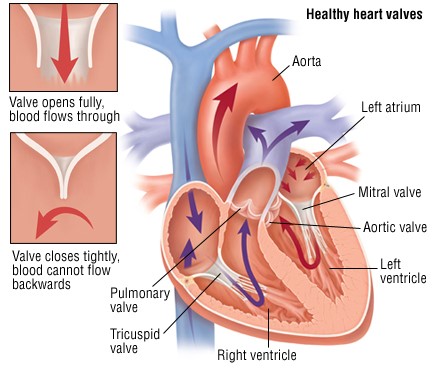
The mitral valve is located on the left side of the heart between the left atrium and left ventricle. As many as 2% of the population may be affected with MVP, also known as Floppy Valve Syndrome or Click Murmur Syndrome. Fortunately, most of those individuals affected will not experience any symptoms or need any treatment. Mitral valve prolapse can occur at any age and is sometimes genetic. In some individuals, often men older than 50, serious symptoms can sometimes occur.
When the mitral valve prolapses, the two valve flaps don’t fully close and this can allow blood to flow back into the left upper heart chamber (left atrium). When the mitral valve prolapses, it allows blood to flow backwards into the heart chamber, this become what is known as mitral valve regurgitation.
For those individuals who are symptomatic, they may experience some chest pain or dizziness/lightheadedness. Fatigue can also be a symptom, as well as shortness of breath that can occur during exertion or when lying flat on one’s back. In patients with severe mitral valve regurgitation, the heart can suffer severe consequences. They include heart enlargement, stroke, arrhythmias, and ultimately may lead to heart failure.
Generally, MVP can be detected when a doctor listens to your chest and hears the characteristic click murmur. Often a non-invasive test called an Echocardiogram is performed. This is an ultrasound that determines how much blood is actually leaking from the valve. If the regurgitation is detected by the echocardiogram, the patient may be referred to a specialist who does another type of more invasive ultrasound called a Transesophageal Echocardiography (TEE). During this procedure, a thin tube is inserted down the throat and into the esophagus. This is done with the patient being under anesthesia. With the TEE, it is possible to get a much clearer image of the heart and the function of the mitral valve, due to the fact that the esophagus is in close proximity to the heart. If the TEE shows severe mitral valve regurgitation, the patient will likely be referred to a cardiac surgeon for mitral valve repair or replacement.
Mitral valve repair is generally preferred over replacement, with many patients able to benefit from a routine repair. Repair can sometimes be done laparoscopically through several small incisions. In fact, many surgeons use robotically assisted tools to repair the valve through small incisions. Sometimes it is necessary to perform these repairs through a larger incision in the chest which involves pulling the muscles out of the way as well as the rib cage. The recovery time is far longer for procedures not done laparoscopically. It can take a minimum of 6 to 8 weeks to recover from open heart surgery. Laparoscopic surgery will allow a patient to be healing much quicker, within 2 weeks of the surgery. Repair can be done through a ring repair called a ring annulopathy. It can also be repaired by the surgeon reshaping the valve and rebuilding it. There is a third type of repair option that involves going through the patients groin with a small catheter to repair the valve. This is generally reserved for patients too sick to go under general anesthesia. When the valve is too damaged to be repaired, it is sometimes necessary to replace it. There are two types of valve replacement options, mechanical and biological. Biological (human or animal) does not last forever. It may be necessary to replace it in 10 to 15 years. What is preferable about this is that a biological valve does not require lifelong blood thinners. Mechanical valves last much longer but due require the patient to be on warfarin for the remainder of their life. Whether it is a repair or replacement, generally the surgeon must place the patient on a heart lung machine to circulate their blood throughout the body while the heart is temporarily stopped during surgery. Immediately following the repair or replacement, the patient is taken off the heart lung machine and the heart restarted. Following the surgery, the patient will spend 3 to 5 days in the hospital following the surgery. Generally, both mitral valve repair and replacement have a very high success rate that allows the patient to resume their normal activities within several weeks to several months.


